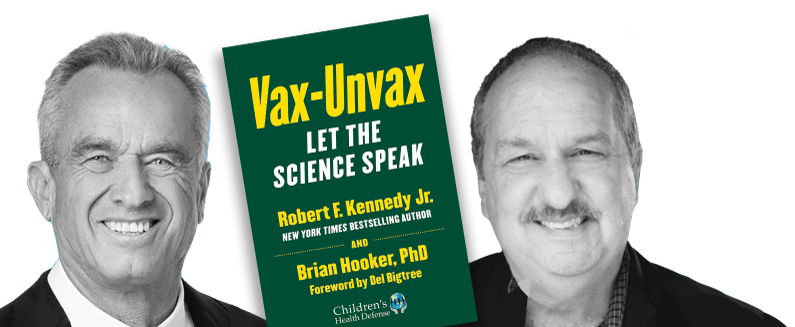‘Autism Epidemic Is Real and Overvaccination Is Its Cause’: A Conversation With Mark Blaxill
Mark Blaxill, chief financial officer of the Holland Center, a private autism treatment center and father of an autistic adult daughter, joined “The Defender In-Depth” this week to discuss what he called the “coming tsunami” of autism caregiving, as the autistic children of the 1990s onward reach adulthood.
Miss a day, miss a lot. Subscribe to The Defender's Top News of the Day. It's free.
April is Autism Awareness Month — or as it’s been rebranded, Autism Acceptance Month.
Every year this time, public health officials, the media and some autism organizations tell us how autism should be celebrated and embraced — how it’s a condition more akin to a quirk than a lifelong disability, one for which a growing number of diagnoses is a sign of “inclusivity.”
Speaking to “The Defender In-Depth” this week — one day after Children’s Health Defense filed a motion in federal court alleging government lawyers hid evidence that vaccines can cause autism — Mark Blaxill, co-author of “Denial: How Refusing to Face the Facts about Our Autism Epidemic Hurts Children, Families, and Our Future,” shared a different view.
Blaxill, chief financial officer of the Holland Center, a private autism treatment center, is the father of an autistic adult daughter. After his daughter’s diagnosis, Blaxill began studying the causes of autism. His research led him to publish “Denial” and several scientific papers on autism.
Blaxill criticized attempts to normalize autism and claims that increases in autism diagnoses are simply due to improvements in detection.
He said public health agencies have repeatedly lied about the causes of autism,
and he warned of a “coming tsunami” of autism caregiving, as the autistic children of the 1990s onward become adults and lose their parents, who are often their caretakers.
‘Sharp inflection point’ after expansion of childhood vaccination schedule
According to Blaxill, when he first began researching autism, the consensus rate of the autism prevalence rate was about 1 in 4,000 to 1 in 5,000. He said he observed at the time that “there was almost no autism in developing nations, that it was pretty much a disease of the developed world.”
“Today we’re talking about 1 in 36, 1 in 29,” Blaxill said. “Things don’t change that rapidly if they’re not real.
Blaxill conceded there are children with autism who never received a vaccine, whose diagnoses were likely due to environmental factors, including exposure to pesticides and other chemicals.
But, he said — quoting autism researcher and author Bernard Rimland — “The autism epidemic is real and overvaccination is its cause.”
There was a “sharp inflection point in 1990” after which autism rates exploded, Blaxill said. The most obvious change that affected children “across the country at a very clear point in time was the change in the childhood immunization practices.”
In 1986, Congress passed the National Childhood Vaccine Injury Act. Blaxill said, “Shortly thereafter, two new vaccines, very high technology vaccines, the hepatitis B vaccine and the Haemophilus influenzae Type B vaccine were introduced. Those two vaccines used thimerosal [an organomercury compound] as a preservative.”
‘Before 1930, the rate of autism in the world was effectively zero’
Blaxill refuted commonly heard claims that autism rates are increasing because methods of diagnosing the condition have improved.
According to Blaxill, the Centers for Disease Control and Prevention (CDC) has, since the birth year of 1992, performed an annual autism prevalence survey. The agency used the same methodology every year to perform the survey.
Blaxill said there are three arguments people use to deny “the reality of an autism epidemic” and explain rising autism cases.
According to the “diagnostic substitution” method, children who used to be classified as having an intellectual disability are now being diagnosed with autism.
“That’s just wrong — the data don’t support that,” Blaxill said. “Intellectual disability rates have stayed pretty constant and autism rates have exploded.”
Another argument, “diagnostic expansion,” claims that criteria for diagnosing autism were broadened by adding conditions such as Asperger’s syndrome to the classification. But even controlling for this, autism rates “are exploding,” Blaxill said.
The third argument, “diagnostic oversight,” holds that autism was always prevalent but went undiagnosed. Blaxill said this argument is “more elusive to refute, but it’s also catastrophically wrong. It’s sloppy, lazy, doesn’t look at historical evidence.”
“Before 1930, the rate of autism in the world was effectively zero,” Blaxill said.
Based on estimates that 100 billion humans have been born since the beginning of time, Blaxill explained that at current levels of diagnosis, this would mean 3.5 billion autistic humans have existed throughout time whose symptoms implausibly went unnoticed.
“There were people writing about childhood development, childhood psychiatry back into the 19th century, and there is not a whisper of autism,” Blaxill said.
Autism isn’t going undiagnosed, according to Blaxill. He alleged, instead, that the data on the causes of autism are being covered up — by government health authorities.
Blaxill said he is “profoundly disillusioned by the corruption that allows industries to “capture” the government agencies that are supposed to regulate them.
“The Department of Health and Human Services is captured by the medical industry, so it only supports narratives that its customers … want to advance.”
Blaxill said government agencies have a financial interest in the success of medicines in general and vaccinations in particular. “The CDC approves and recommends vaccinations,” he said. “The CDC, over time, has done their best to cover up this epidemic … the agency learned how to lie with autism, and they’ve lied at every turn.”
He cited the CDC’s manipulation of autism prevalence rates and refusal to study the entire childhood vaccination schedule in connection with autism, even though “it is most likely the biggest culprit.”
He said:
“Everybody in the medical field looks at illness and sickness as an opportunity to make money. Whether you’re in government, you can get more funds, you can get more budgets, you can get promotions, you can have a career, whether you’re in Pharma, you can get a blockbuster new drug or a blockbuster new vaccine.”
Efforts to normalize and celebrate autism ‘cheapen that disability’
Blaxill criticized attempts to normalize and celebrate autism.
Noting that the CDC stopped referring to autism as an urgent public health concern, Blaxill said Most of what the agency talks about now is, “Oh, let’s celebrate the fact that Black and Hispanic rates of autism are catching up to the white rates of autism, and we’re doing as good a job discovering autism in Black and Hispanic children.’”
Blaxill said that while he wants to celebrate his autistic daughter, he doesn’t want “to celebrate her disability or what happened to her because when I’m gone and when her mother is gone, there will be no one for her.”
“My daughter’s disabled for life. Don’t cheapen that disability by pretending that the fact that you’re a little nerdy makes you autistic. No, it’s not,” Blaxill said.
‘A tsunami of costs that has no end’ in the coming decades
Blaxill co-authored a peer-reviewed paper warning of an upcoming “autism tsunami” as autistic children born in the 1990s and 2000s reach adulthood. The paper, published in 2022 in a Springer journal, was retracted and subsequently published in another journal.
“Those numbers are going to keep going up. … Over time, therefore, we’re going to see a cost of disease evolution that’s dramatic and very concerning,” he said.
Early in life, autism is very costly to parents, including mothers who often are obliged to stay home and abandon their careers. “Over time, those costs shift,” he said, as “the parents retire, the parents die.”
“Most autistic individuals in adulthood are unemployed and unemployable … Then they’re going to have to be housed somewhere and they’re going to have to have something to do during the day. Someone’s got to watch over them,” Blaxill said.
“The cost per individual is always large … anywhere between $20,000-$100,000 [per year],” Blaxill said. “If you take that cost per individual and you change the whole population distribution of those individuals over time from 2025 to 2030 to 2040 to 2060, you see a tsunami of costs that has no end.”
“The infrastructure, the social services, the educational services to service this population is going to be incredibly strained in the decades ahead. It’s going to cost, on a national basis, trillions of dollars annually to serve this population,” Blaxill said.
“I don’t know where the money’s going to come from. I don’t know where the infrastructure is going to be built. And these kids are at huge risk when they grow up being abandoned in warehouses with no one to take care of them,” he said.
Watch ‘The Defender In-Depth’ here:
Listen to the podcast on Spotify.
‘The Defender In-Depth’ airs on CHD.TV Wednesday at 10 a.m. ET/9 a.m. CT.
Sign up for free news and updates from Children’s Health Defense. CHD focuses on legal strategies to defend the health of our children and obtain justice for those injured. We can't do it without your support.







No comments:
Post a Comment